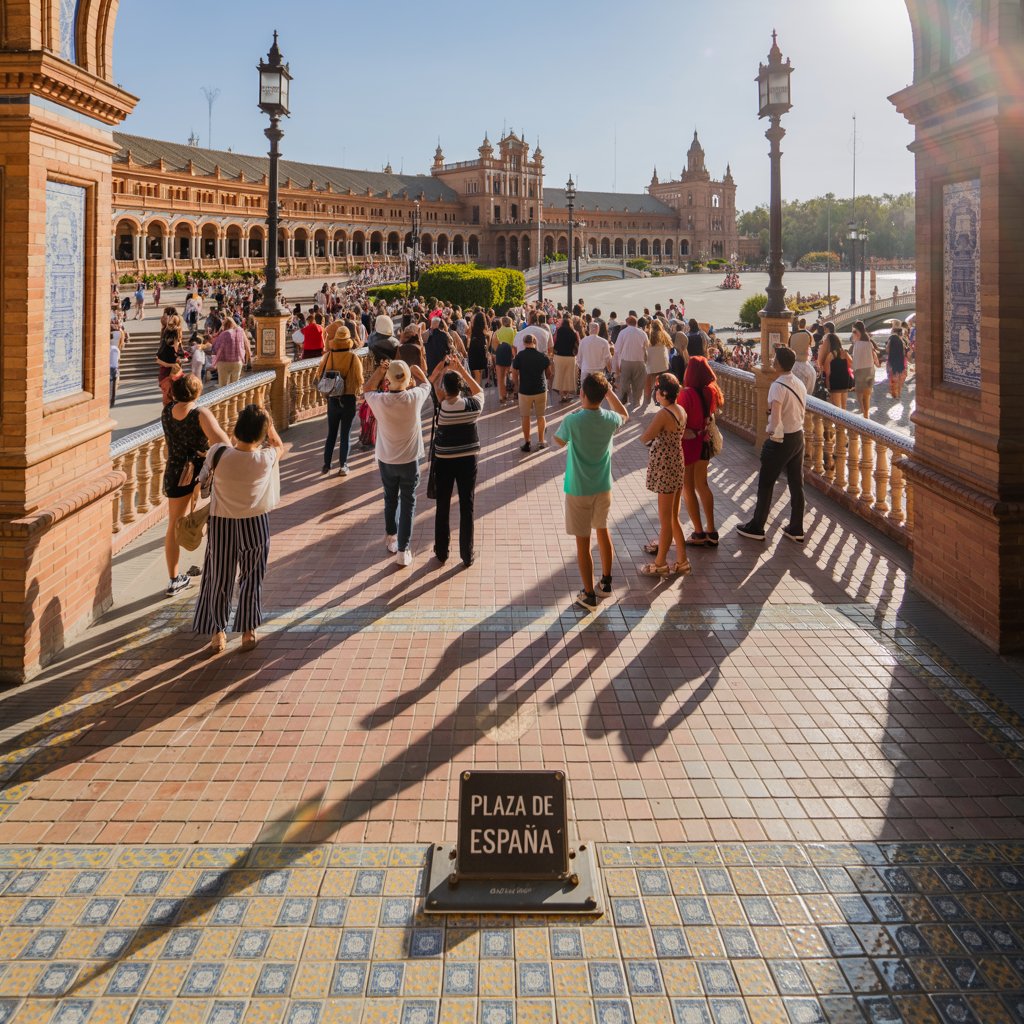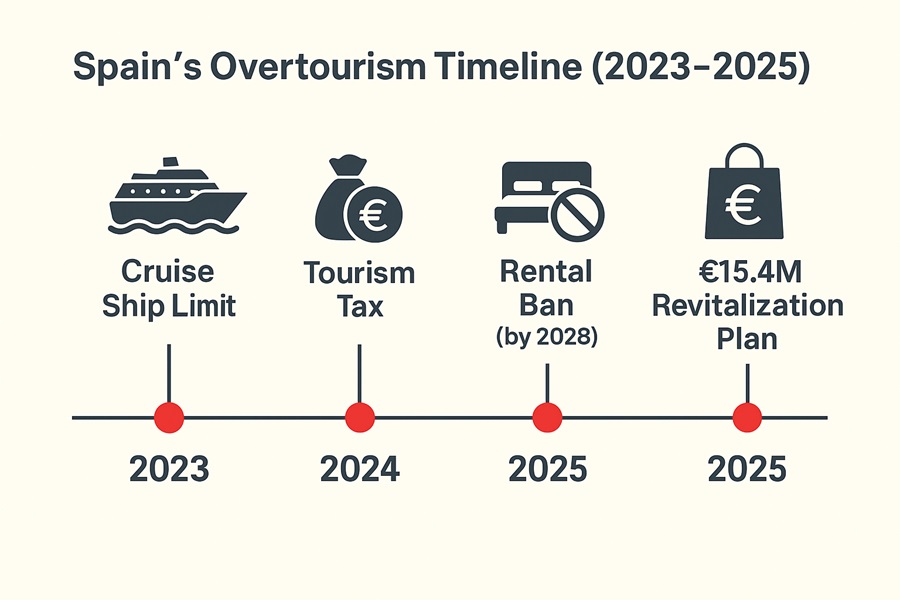Spain is getting 85 million tourists in 2024 alone. As pressure mounts on cities like Barcelona and islands like Mallorca, locals are calling for sustainable travel in Spain—and tourists have a part to play.
A viral X post from 2025 shows: in Barcelona, locals tape off hotel exits and spray tourists with water guns, fed up with overtourism. With 2025 numbers rising, the strain on communities and landscapes is clear. From housing crises in Barcelona to littered beaches in Mallorca, the overtourism crisis is sparking protests and heated debates on social media. Locals aren’t just annoyed—they’re demanding change.
This guide explores the social and environmental impacts of overtourism in Spain, based on X posts and recent data, and offers cultural do’s and don’ts to help you travel more responsibly. By understanding these issues and being mindful, you can enjoy Spain’s culture without contributing to the problems.
Latest Overtourism Hotspots in Spain
Water Gun Protests in Barcelona and Mallorca (June 2025)
In June 2025, protests in Barcelona and Palma de Mallorca went viral worldwide. Locals took to the streets with water pistols, smoke flares and homemade signs to express anger over mass tourism, housing displacement and loss of quality of life. Protesters even sprayed hotel entrances and workers, chanting slogans like “Tourism steals our bread, homes and future.”
These symbolic actions, shared across X and TikTok, became the face of Spain’s growing anti-tourism movement.
Canary & Balearic Island Protests (April–July 2024)
Earlier protests in 2024 saw 20,000–50,000 people across the Canary Islands, Balearic Islands and Barcelona march against unchecked tourism. These included taped hotel closures and anti-cruise ship demos.
Barcelona responded by saying it will ban new short-term rentals by 2028 and increase tourist taxes to mitigate overtourism.
Sagrada Família Neighborhood Crisis (August 2025)
Residents near La Sagrada Família say over 70% of local businesses now only serve tourists. Grocers, fishmongers and traditional bakeries are being replaced by souvenir shops. Despite a €15.4 million municipal plan to combat this, locals claim it’s getting worse.
Legal Action in Madrid (July 2025)
A Madrid judge has ordered 10 tourist flats shut down after a local family sued for noise, public drunkenness and lack of cleanliness. The court awarded them €39,000 in damages and now the whole country is debating the uncontrolled growth of short-term rentals.
What Is Spain Doing About Overtourism? A Policy Timeline
While protests and social media posts are in the headlines, Spain’s local and national governments are taking action to combat overtourism. But how effective and urgent are these measures?
| Year | Action Taken | Region | Intended Impact | Status |
| 2023 | Introduction of cruise ship docking restrictions | Palma de Mallorca, Barcelona | Limit daily mass arrivals | Partially implemented |
| 2024 | Anti-tourism protest responses: increased tourism tax | Balearic & Canary Islands | Fund conservation efforts | Ongoing |
| 2024 | Short-term rental caps & enforcement pledges | Madrid, Seville, Barcelona | Reduce Airbnb-driven housing shortages | Under-enforced |
| 2025 | Barcelona announces a ban on new short-term rentals by 2028 | Barcelona | Slow tourism expansion & ease housing strain | Widely criticized as too slow |
| 2025 | €15.4M revitalization plan to protect small businesses | Sagrada Família District | Preserve local commerce over tourist shops | Limited impact so far |
Key Insight: While these steps show increasing awareness, most actions are delayed, piecemeal, or unevenly enforced—especially in popular cities like Barcelona and Palma.

Overtourism in Spain: Social and Environmental Impacts Explained
Social Impacts: A Strained Way of Life
Overtourism is reshaping Spanish communities, particularly in Barcelona, Madrid, and the Balearic and Canary Islands. The social toll is profound:
- Housing Crisis: Platforms like Airbnb have driven up housing prices, displacing locals from central neighborhoods. In El Born (Barcelona), tourist rentals outnumber local homes. In Mallorca, over 1,000 people were living in cars in 2024 due to housing shortages.
- Loss of Community Identity: Traditional shops are being replaced by souvenir stores and chain restaurants. Seville’s historic center is increasingly described as a “theme park” by frustrated locals.
- Social Inequality: Most tourism revenue flows to outside investors. Meanwhile, a third of Canary Islands residents were at risk of poverty in 2023, despite the tourism boom.
- Strain on Services: On peak days, over 200,000 tourists visit La Rambla in Barcelona, clogging transport and healthcare services. Many locals report feeling unwelcome in their own city.
Environmental Impacts: A Landscape Under Pressure
- Pollution and Litter: Popular beach spots like the Puntal in Mallorca are plagued with trash from drinking parties, threatening marine life.
- Ecosystem Damage: Natural spaces like Tenerife’s forests and protected coastal zones face overuse and illegal development, including luxury villas.
- Carbon Emissions: Cruise ships docking in Barcelona unload thousands of tourists at once, sharply increasing carbon output.
- Water and Waste Strain: The Canary Islands face growing water shortages and overflowing waste systems, driven largely by tourism.
Spain’s Tourism Growth vs. Community Impact
Spain is the second most visited country in the world, but high visitor numbers don’t necessarily equate to positive outcomes for residents. This chart reveals the tradeoffs:
| Metric | 2019 | 2024 | % Change | Notes |
| Total International Visitors | 83 million | 85 million | +2.4% | Rebounded post-COVID |
| Cruise Ship Arrivals (Barcelona) | 4.5 million | 6.8 million | +51% | Sharpest increase since 2018 |
| Mallorca Residents Living in Cars | N/A | 1,000+ | — | Result of housing saturation |
| Canary Islands Poverty Rate | 28% | 33% | +5% | Despite record tourism |
| % Local Shops in Sagrada Família (Tourist-centric) | 40% | 70% | +30% | Massive loss of neighborhood commerce |
Conclusion: Spain’s reliance on tourism has created imbalances between economic gain and social well-being, particularly in major tourism corridors.
Cultural Don’ts That Worsen the Crisis
- Avoid short-term rentals in hot spots like El Born (Barcelona).
- Don’t litter or damage natural parks like those in Tenerife.
- Obey local laws: bikinis are banned outside the beach in Barcelona.
- Don’t treat landmarks as props: use audio guides to understand the history.
- Skip peak summer (July–August) in favor of spring or fall visits.
What You Can Do: Practical Tips for Sustainable Travel in Spain
- Use Renfe trains and bike rentals over rental cars or planes.
- Visit less-touristed towns like Ronda, Cádiz, and La Palma.
- Minimize waste with reusable water bottles and tote bags.
- Follow local hashtags like #SpainTravelTips and #Overtourism for real-time sentiment.
Popular vs. Sustainable Alternatives
| Overtouristed Area | Sustainable Option | Why It’s Better |
| El Born (Barcelona) | Ruzafa (Valencia) | Local culture, fewer tourists |
| Mallorca beaches | Inland towns like Deià | Preserved nature, local economy boost |
| La Rambla (Barcelona) | Gràcia neighborhood | Authentic feel, less crowded |
| Canary resort sprawl | Eco-lodges in La Palma | Conservation-friendly and legally regulated |
Destination-Specific Sustainable Travel Tips
Barcelona
- ✅ Visit La Sagrada Família early.
- ❌ Don’t block walkways in La Rambla for photos.
Mallorca
- ✅ Explore Deià or Sòller instead of crowded beaches.
- ❌ Avoid party zones and respect natural parks.
Canary Islands
- ✅ Choose eco-certified lodgings and pay tourist taxes.
- ❌ Don’t stay in illegally built luxury accommodations.
Travel Smarter: 5 Fast Tips for Sustainable Travel in Spain
- Use bikes or trains over rental cars.
- ️ Choose eco-labeled hotels, not Airbnbs in saturated areas.
- Shop at local markets, not chains.
- Attend cultural workshops like flamenco classes or paella cooking.
- ️ Learn greetings: “Bon dia” (Catalan), “Eskerrik asko” (Basque), “Buenas tardes” (Spanish).
Turning Tensions into Connections
One X user shared how a visitor joined a local cleanup crew in Barcelona, earning genuine gratitude from residents. These are the kinds of actions that turn negative perceptions into positive ones.
You don’t need to be perfect. You just need to care.
How Spain Ranks Among Overtourism Hotspots
Spain isn’t alone. Other popular destinations are facing similar challenges. Here’s how Spain compares:
| Country | 2024 Visitors | Main Complaints | Notable Response |
| Spain | 85 million | Housing, pollution, crowding | Rental caps, cruise limits, taxes |
| Italy | 70 million | Venice overrun, degradation of landmarks | Tourist tax, cruise ship ban in Venice |
| Thailand | 39 million | Environmental destruction | Closure of Maya Bay for 3 years |
| France | 79 million | Urban crowding, pressure on museums | Short-term rental regulation in Paris |
| Iceland | 2.2 million (2023) | Infrastructure overuse | Tourist cap proposals, sustainability certification |
✈️ Bottom Line: Spain is among the most tourism-dependent nations, but its policy response is slower compared to more aggressive measures seen in Italy or Thailand.
Conclusion: Sustainable Travel Spain Is the Future
Spain’s overtourism crisis is real—and rising. But it doesn’t have to be inevitable.
With a little awareness and cultural respect, travelers can shift the tide. From avoiding peak crowds to supporting rural economies and choosing eco-lodging, the path forward is clear.
Join the movement. Share your story on X with #SpainTravelTips and make sustainable travel in Spain not just a concept—but a community effort.



